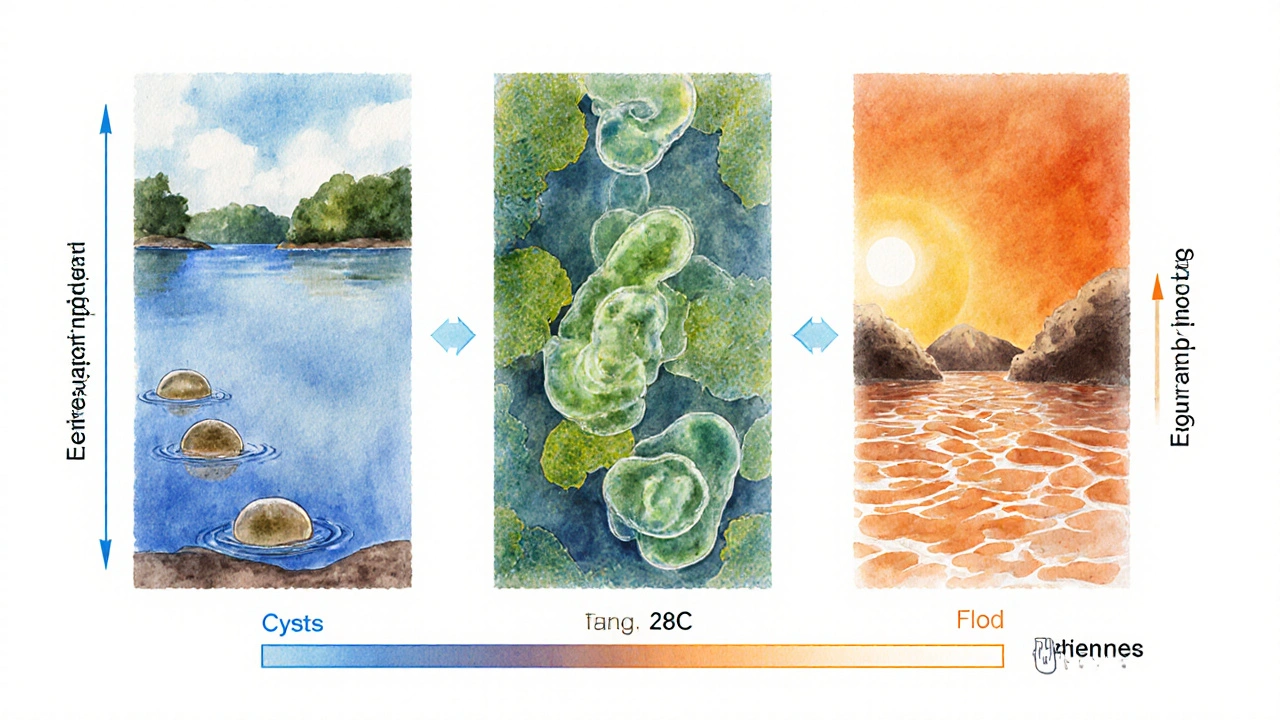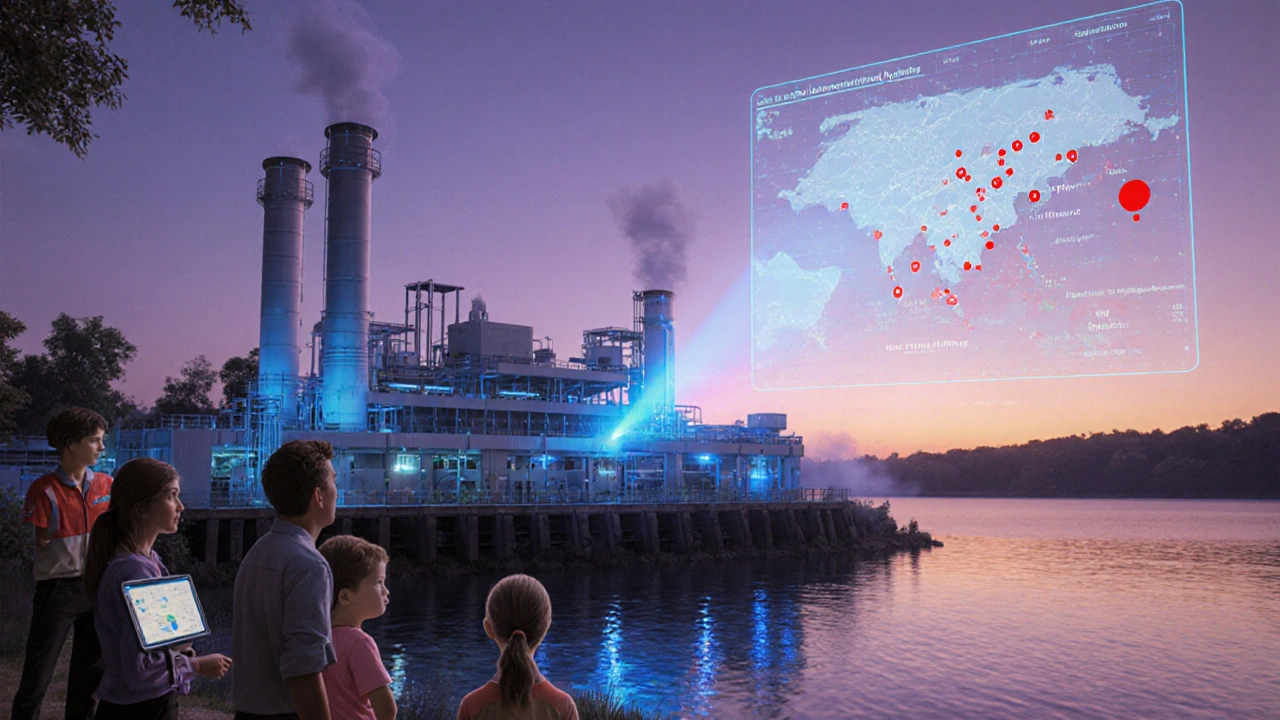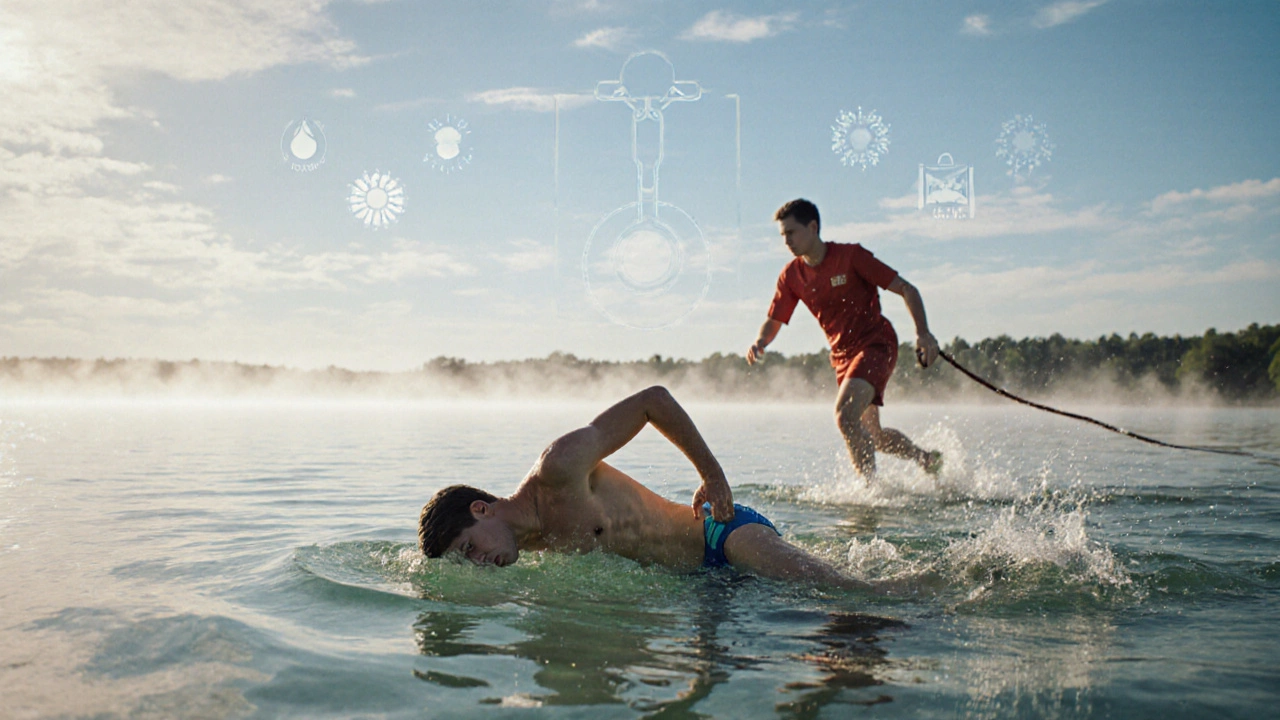Amoeba Infection Risk Calculator
Water Temperature Risk Assessment
Enter the water temperature to see current infection risk levels based on climate change data from the article.
Risk Assessment Results
When a teenager in the United States suddenly collapsed after swimming in a warm lake, doctors discovered a rare brain‑eating parasite called Naegleria fowleri, a free‑living amoeba that thrives in heated freshwater and can cause fatal brain infection. That tragedy is no longer an isolated freak accident. In the last decade, reports of amoeba infections have climbed alongside rising global temperatures, prompting scientists to ask: is climate change turning our waterways into breeding grounds for deadly microbes?
Key Takeaways
- Warmer freshwater and more extreme weather events create ideal conditions for pathogenic amoebae.
- Documented cases of Naegleria fowleri and Acanthamoeba infections have increased by roughly 30% since 2000.
- Public health surveillance, water‑treatment upgrades, and public awareness are critical to curb the trend.
- Future research must focus on predictive modeling that links climate data to infection risk.
How Climate Change Alters Freshwater Environments
Climate change, the long‑term shift in temperature and weather patterns caused primarily by human‑generated greenhouse gases does more than raise sea levels. It rewrites the thermal profile of lakes, rivers, and reservoirs. As global temperature rise climbs toward 1.5°C above pre‑industrial levels, average freshwater temperature has increased by 0.6‑1.0°C in many temperate zones.
This rise in freshwater temperature, the degree of heat in lakes, ponds, and streams shortens the winter dormancy period for many microorganisms. Warmer water also speeds up the reproductive cycle of free‑living amoebae, allowing their populations to explode within a single summer season.
Extreme weather events-heavy rains, floods, and droughts-further amplify the risk. Floodwaters can transport soil‑borne cysts into recreational lakes, while drought lowers water levels, concentrating heat and nutrients. Both scenarios create perfect breeding conditions for pathogenic amoebae.

Amoeba Life Cycle and Why Heat Matters
Pathogenic amoebae, such as Naegleria fowleri, an amoeba that lives in warm freshwater and can invade the human brain via the nasal passages and Acanthamoeba castellanii, a widespread amoeba that can cause eye infections and, in rare cases, brain disease, have three main stages: cyst, trophozoite, and, for N.fowleri, a temporary flagellate form. The cyst is a resilient, dormant shell that survives cold or dry periods. Once water warms above 25°C, cysts transform into the active trophozoite, which feeds, multiplies, and can infect humans.
Laboratory studies show that at 30°C, N.fowleri can double its population in less than 24hours, while at 20°C the same growth takes several days. Hence, a modest 3‑4°C increase can translate into orders of magnitude more infectious amoebae in the water.
Documented Rise in Cases Linked to Climate Trends
Global surveillance data reveal a concerning upward trend. In 2000, the World Health Organization recorded about 140 confirmed cases of Naegleria‑related primary amoebic meningoencephalitis (PAM) worldwide. By 2024, that number climbed to roughly 190, despite improved diagnostic methods-a 35% increase.
Similarly, Acanthamoeba keratitis cases, often tied to contact‑lens hygiene but also influenced by water exposure, have risen in sun‑belt regions of the United States and Southern Europe. Studies from the University of Queensland show a 28% increase in reported keratitis cases between 2005 and 2022, correlating with hotter summers.
To illustrate the climate‑infection link, see the table below.
| Year | Avg Global Temp Anomaly (°C) | Reported Cases Worldwide |
|---|---|---|
| 2000 | 0.4 | 140 |
| 2005 | 0.5 | 152 |
| 2010 | 0.6 | 165 |
| 2015 | 0.8 | 171 |
| 2020 | 1.0 | 182 |
| 2024 | 1.1 | 190 |
While correlation does not prove causation, the parallel rise in temperature anomalies and infection reports strengthens the hypothesis that climate‑driven warming fuels amoeba proliferation.
Public Health Surveillance and Early Warning
Effective response hinges on robust public health surveillance, systematic collection, analysis, and dissemination of health data to guide interventions. Many countries now include amoebic infections in their notifiable disease lists. In the United States, the CDC’s Waterborne Disease and Outbreak Surveillance System (WBDOSS) logs each suspected PAM case, enabling rapid geographic mapping.
Environmental monitoring programs also sample popular swimming spots during peak summer months. For example, the Colorado Department of Public Health collects water samples weekly, testing for Naegleria DNA via quantitative PCR. Early detection allows authorities to post warnings or temporarily close contaminated sites.
Integrating climate data-such as satellite‑derived surface temperature and precipitation forecasts-into these surveillance platforms can generate predictive risk maps. Regions projected to exceed 30°C water temperature for more than ten consecutive days can be flagged for intensified testing.

Prevention Strategies for Individuals and Communities
While governments upgrade water‑treatment infrastructure, everyday actions can dramatically lower personal risk.
- Avoid warm, stagnant water: Skip diving into hot springs, poorly maintained pools, or shallow ponds during heatwaves.
- Use nose clips: If you must enter warm freshwater, a simple nose clip keeps water from rushing up the nasal passages- the primary entry route for N.fowleri.
- Maintain proper water treatment: Municipalities should monitor chlorine levels, aiming for at least 0.5mg/L free chlorine, which can inactivate many amoebae.
- Improve drainage and runoff control: Urban planners can reduce flood‑driven cyst spread by installing bio‑retention basins and vegetated swales.
- Educate at‑risk groups: Parents, coaches, and outdoor enthusiasts should receive brochures outlining safe water practices, especially before major heat events.
For contact‑lens wearers, the link between Acanthamoeba keratitis and improper lens cleaning is well documented. Using sterile solution, avoiding tap water for rinsing, and replacing lenses on schedule cut the risk dramatically.
Future Outlook and Research Priorities
Predictive modeling is the next frontier. Researchers are developing algorithms that combine climate projections, hydrological data, and amoeba growth curves to forecast infection hotspots a decade ahead. Such models could inform where to prioritize water‑treatment upgrades and public‑education campaigns.
Another promising avenue is exploring anti‑amoebic water treatments that remain effective at higher temperatures. Current chlorine protocols lose potency as water warms, so alternatives like ozone or UV‑LED systems are under evaluation.
Finally, interdisciplinary collaboration-bringing together climatologists, microbiologists, epidemiologists, and policy makers-is essential. Only a coordinated effort can turn the tide against a threat that silently rides the warming currents of our planet.
Frequently Asked Questions
What exactly is Naegleria fowleri?
Naegleria fowleri is a free‑living amoeba that lives in warm freshwater. When water containing the amoeba enters the nose, it can travel to the brain and cause a rapidly fatal disease called primary amoebic meningoencephalitis (PAM).
How does climate change make these infections more likely?
Higher air and water temperatures shorten the dormant cyst phase and speed up amoeba multiplication. Extreme weather events also move cysts into new water bodies, expanding the geographic range where infections can occur.
Are there any early signs of infection?
Symptoms usually appear 2‑9 days after exposure and include severe headache, fever, nausea, and stiff neck. The disease progresses quickly, so medical attention must be sought immediately if these signs appear after swimming in warm freshwater.
Can water treatment eliminate the threat?
Standard chlorine dosing can reduce amoeba levels, but effectiveness drops at temperatures above 30°C. Advanced treatments like ozone, UV‑LED, or combined filtration are being studied for better performance in warm water.
What simple steps can I take when swimming?
Avoid submerging your head in hot, stagnant water, use nose clips, and rinse your face with clean water after swimming. Children should be supervised closely, especially during heatwaves.


Bryan Kopp
October 12, 2025 AT 23:13Feels like the climate alarmists are always shouting about the worst-case scenarios, but the reality hits home when you hear about a teenager's tragic death. I keep thinking about how many warm lakes we have across the states, each a potential hidden danger. Even though I’m not a scientist, the increasing numbers in the report make me uneasy, especially when it’s our own backyard that’s at risk.
Brenda Hampton
October 13, 2025 AT 13:06That story really drives home why we need to stay proactive, not just reactive. If more communities adopt regular water testing and share clear safety tips, we could cut down those scary numbers fast. People love the outdoors, so giving them simple steps-like using nose clips and checking temperature alerts-keeps the fun alive while keeping health risks low.
Lara A.
October 14, 2025 AT 03:00Wake up!!! The so‑called “climate change” narrative is just a cover‑up for a massive government experiment on waterborne pathogens!!! They want us scared so they can push secret labs into our lakes!!!
Robyn Chowdhury
October 14, 2025 AT 16:53While the data presented is undoubtedly significant, one must also consider the broader philosophical implications of humanity's impact upon natural ecosystems. The notion that our collective negligence could foster microscopic monsters is both tragic and poetically dark. 🌊🧠
Deb Kovach
October 15, 2025 AT 06:46First, it’s essential to understand that Naegleria fowleri thrives in water that consistently stays above 25 °C, which means even modest summer heat waves can create ideal breeding grounds. Regular monitoring of popular swimming spots with quantitative PCR testing can detect low‑level amoeba DNA long before an outbreak occurs. Municipal water treatment facilities should aim for a free chlorine residual of at least 0.5 mg/L, as studies show this concentration can inactivate a significant portion of trophozoites. When temperatures rise above 30 °C, chlorine efficacy drops, so integrating supplemental treatment methods such as ozone or UV‑LED systems becomes critical. Public health agencies can issue heat‑related risk advisories that combine real‑time temperature data with historical infection patterns to warn swimmers proactively. Education campaigns targeted at schools, sports clubs, and outdoor recreation groups can spread simple protective measures: use of nose clips, avoiding submerging the head in warm stagnant water, and thorough rinsing after water exposure. Contact‑lens wearers should be reminded that even a brief splash of contaminated water into the eyes can seed Acanthamoeba keratitis, emphasizing the need for sterile solutions and proper lens hygiene. Moreover, community‑level interventions, like installing bio‑retention basins, can reduce runoff‑borne cysts from reaching lakes and reservoirs during heavy rains. Researchers are currently developing predictive models that fuse satellite‑derived surface temperature data with hydrological flow patterns to forecast high‑risk zones months in advance. These models, once validated, could guide where to prioritize infrastructure upgrades and allocate resources for intensified surveillance. It is also worth noting that early‑stage symptoms of primary amoebic meningoencephalitis often mimic common flu, so clinicians should maintain a high index of suspicion in patients presenting with severe headache after recent freshwater exposure. Prompt administration of experimental anti‑amoebic therapy, such as miltefosine, has been linked to improved survival odds, though the window for effective treatment remains narrow. Finally, interdisciplinary collaboration among climatologists, microbiologists, epidemiologists, and policymakers is not just beneficial-it is necessary to stay ahead of this emerging threat. By combining robust data collection, community education, and advanced treatment technologies, we can mitigate the rising risk posed by a warming planet.
Sarah Pearce
October 15, 2025 AT 20:40i think the article is pretty solid,, but they coulda definitely added more on how to check water temp!! also the formatting is a little off, but whatevs.
Ajay Kumar
October 16, 2025 AT 10:33Totally get what you’re saying-clear, actionable guidance makes a huge difference for everyday folks. I’ve seen local parks post simple temperature charts near the entry points, and it really helps families decide whether to dive in or not. Adding a quick “check the signs” reminder on popular beach websites would be a low‑cost win. Plus, sharing stories of safe swims can inspire more people to follow the precautions without feeling scared.
Richa Ajrekar
October 17, 2025 AT 00:26While the information is valuable, I must point out several grammatical inaccuracies throughout the text, such as inconsistent use of commas and misplacement of apostrophes. Proper editing would enhance credibility and ensure readers focus on the critical health messages rather than be distracted by sloppy language.
Rebecca Ebstein
October 17, 2025 AT 14:20Great eye for detail! Fixing those little errors will only make the already powerful message shine brighter. Keep the positive vibes coming! 😊
Artie Alex
October 18, 2025 AT 04:13The pathogen’s thermotolerance threshold, coupled with anthropogenic thermal loading of freshwater ecosystems, precipitates a non‑linear escalation in the basic reproductive number (R0) of Naegleria spp. This phenomenon underscores the necessity for integrating climatological indices into epidemiological surveillance frameworks. Moreover, the attenuation of chlorination efficacy at elevated temperatures mandates a paradigm shift toward multimodal disinfection protocols. Stakeholders must therefore allocate resources toward advanced oxidative processes to curtail the emergent public health menace.
abigail loterina
October 18, 2025 AT 18:06Exactly, we need to make this science accessible to everyone, not just experts. Simple messages about using nose clips and checking water temperature can empower communities to protect themselves. Let’s keep the conversation inclusive and supportive.
Roger Cole
October 19, 2025 AT 08:00Stay safe and keep an eye on water temps.